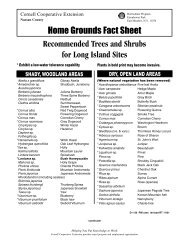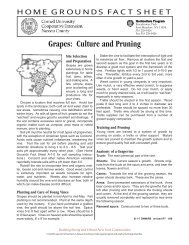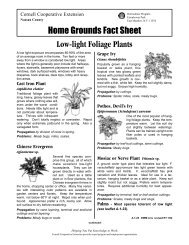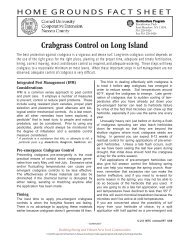C-2-2 Recognizing Broadleaf Weeds In Lawns - Cornell ...
C-2-2 Recognizing Broadleaf Weeds In Lawns - Cornell ...
C-2-2 Recognizing Broadleaf Weeds In Lawns - Cornell ...
You also want an ePaper? Increase the reach of your titles
YUMPU automatically turns print PDFs into web optimized ePapers that Google loves.
HOME GROUNDS FACT SHEET<br />
Cooperative Extension<br />
Nassau County<br />
Nassau County<br />
Horticulture Program<br />
Eisenhower Park<br />
East Meadow, NY 11554<br />
516 228-0426<br />
<strong>Recognizing</strong> <strong>Broadleaf</strong> <strong>Weeds</strong> in the Lawn<br />
Black Medic<br />
Black medic, an annual, is often called “black clover.”<br />
The leaves, with very few exceptions, are<br />
similar to clover. Its flowers<br />
are yellow and their tightly<br />
coiled black pods contain a<br />
single seed when mature.<br />
Its stems are prostrate and<br />
branched, forming low mats.<br />
Low nitrogen causes black<br />
medic. Check fertility.<br />
Buckhorn<br />
Narrow-leaf plantain, often called buckhorn, is a<br />
perennial weed. Its thick, fleshy roots develop numerous<br />
lateral rootlets that make it difficult to eradicate<br />
by hand. Even small pieces that may be left<br />
behind are capable of forming new plants. It is a<br />
prolific seeder, producing<br />
many hundreds of seeds<br />
per plant. The seedheads,<br />
which develop in late spring<br />
and summer, often escape<br />
the reel mower and become<br />
unsightly. Compaction often<br />
leads to plantain invasion.<br />
Core aerate in spring and/or fall.<br />
Clover<br />
Clover is often considered a troublesome perennial<br />
pest. It attracts bees, a serious threat to those who<br />
are allergic to their sting. Clover is soft and slippery<br />
to walk on. It stains clothing more than other<br />
grasses. Since it grows in patches, it often breaks<br />
up the continuity of an evenly textured lawn. Many<br />
people like clover during the summertime<br />
when lawn grasses tend to<br />
become somewhat dormant.<br />
Sometimes, it is the only plant<br />
left after chinch bugs invade.<br />
Low nitrogen or a dry year may<br />
bring on an outbreak of clover.<br />
Common Chickweed<br />
Common chickweed is an annual or winter annual<br />
that reproduces and spreads not only by seeds, but<br />
by rooting at the nodes of the stem. This weed<br />
thrives best in early spring or late autumn during<br />
cool, moist weather. It does not grow well during hot<br />
weather, except in moist or shady situations. Its<br />
presence is a sign of inadequate turf cover. The<br />
leaves are small, opposite<br />
and pointed at the tips.<br />
Shade will increase<br />
chickweed by thinning<br />
turf. Cut back tree<br />
branches to increase<br />
light.<br />
Dandelions<br />
These are perennial weeds that need no introduction.<br />
There are two species, and both may exist in<br />
the same lawn. They have long, fleshy roots that, if<br />
not completely extricated,<br />
usually start new growth.<br />
On the credit side, their<br />
young leaves are used<br />
as salad greens and<br />
their flowers make an<br />
acceptable wine. Thin<br />
turf will have many<br />
dandelions. Check fertility.<br />
Plantains<br />
There are two species of perennial broad-leafed<br />
plantains. Plantago rugelii is generally<br />
larger and smoother than Plantago<br />
major and its leaves tend<br />
to have wavy margins with<br />
purplish petioles.<br />
Compaction can cause<br />
an increase in plantains.<br />
Core aerate in spring<br />
and/or fall.<br />
C-2-2 MTC TTY revised RT 1/03
Knotweed<br />
Knotweed is an annual pest that germinates in late<br />
winter to early spring, or about the same time grass<br />
greens up in the spring. It grows so close to the<br />
ground that it gives a turf-like appearance when<br />
mowed. Before it is killed by the frost, it sets a new<br />
crop of seed to reinfest the soil for the following<br />
season. Patches of this weed have a red-brown<br />
color after killing frosts.<br />
It thrives in hard,<br />
trampled areas that<br />
are subject to<br />
excessive compaction.<br />
Core aerate several<br />
times a year and<br />
incorporate organic matter.<br />
Mouse-ear Chickweed<br />
Mouse-ear chickweed is a low-creeping perennial<br />
with very hairy leaves shaped like a mouse’s ear. It<br />
is usually a darker green than common chickweed.<br />
The creeping stems run along the soil surface,<br />
where they sometimes form dense mats and destroy<br />
the<br />
grass. Flowers appear<br />
at the tips of the<br />
branches. Shade will<br />
bring on chickweed in<br />
thin turf. <strong>In</strong>crease<br />
light by cutting back<br />
any tree branches.<br />
Oxalis (Yellow Wood Sorrel)<br />
This is a persistent perennial weed. The plant is<br />
upright but will root at the lower nodes. The heartshaped<br />
leaves resemble clover. They are usually<br />
pale green. Other species can be reddish or purplish.<br />
The small<br />
yellowish flowers have<br />
5 petals. Seedpods are<br />
distinctly elongated;<br />
when ripe and dry, the<br />
slightest touch will send<br />
the seeds flying for<br />
several feet. Dry soils<br />
will cause an increase<br />
in yellow wood sorrel.<br />
Red Sorrel (Sheep Sorrel)<br />
The name sorrel, signifying sour, is applied to a<br />
number of unrelated plants that have a bitter acid<br />
principal in their roots, stems or leaves. This weed<br />
spreads readily in lawns and gardens because of its<br />
perennial, running rootstocks. It is particularly vigorous<br />
in soils that are acid and low in plant nutrients -<br />
naturally or because of under-fertilization. <strong>In</strong> the<br />
spring, the plant develops branching stalks of tiny<br />
flowers. The female flowers are reddish brown. Red<br />
sorrel indicates a neglected<br />
lawn. Proper maintenance<br />
such as keeping pH,<br />
nutrients and moisture<br />
levels in the proper range<br />
will help. Low pH leads<br />
to sorrel increase. Check<br />
pH and add appropriate<br />
amounts of lime.<br />
Prostrate Spurge<br />
Prostrate spurge is an annual weed that grows in<br />
well-nourished lawns or gardens and branches freely.<br />
It forms broad mats that eventually smother grass.<br />
The leaves vary from dark green to red, but generally<br />
bear purplish-brown blotches on the upper surface.<br />
An easy way<br />
to identify this weed<br />
is to tear off a leaf<br />
stem or shoot; it will<br />
bleed a milky juice.<br />
Spurge indicates a<br />
dry year or a dry spot.<br />
<strong>In</strong>crease soil moisture.<br />
Wild Garlic<br />
Often referred to as “wild onion,” it’s not a broadleaf<br />
weed, but is controlled by the same materials.<br />
Crushed or cut plant parts<br />
have the typical strong<br />
onion odor. It produces<br />
underground bulbs and<br />
bulblets. Green clumps of<br />
this weed are frequently<br />
noticeable in the very<br />
early spring. Repeated<br />
low mowing, early in the<br />
season before grass has<br />
broken dormancy, can<br />
help to reduce wild garlic.<br />
<strong>In</strong>tegrated Pest Management Practices (IPM)<br />
A healthy, densely growing lawn will usually have fewer weeds than a lawn with many bare spots. Therefore, spot<br />
seeding any open areas will reduce the chances of weed seeds being blown onto the lawn. If an herbicide is<br />
necessary, it is best to spot treat individual weeds instead of treating the entire lawn.<br />
WHENEVER YOU USE A PESTICIDE, ALWAYS READ THE LABEL AND<br />
FOLLOW THE MANUFACTURER’S INSTRUCTIONS AND RECOMMENDATIONS.<br />
C-2-2 MTC TTY revised RT 1/03








